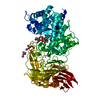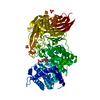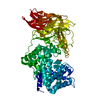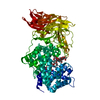[English] 日本語
 Yorodumi
Yorodumi- PDB-1egu: CRYSTAL STRUCTURE OF STREPTOCOCCUS PNEUMONIAE HYALURONATE LYASE A... -
+ Open data
Open data
- Basic information
Basic information
| Entry | Database: PDB / ID: 1egu | ||||||
|---|---|---|---|---|---|---|---|
| Title | CRYSTAL STRUCTURE OF STREPTOCOCCUS PNEUMONIAE HYALURONATE LYASE AT 1.56 A RESOLUTION | ||||||
 Components Components | HYALURONATE LYASE | ||||||
 Keywords Keywords | LYASE / (alfa5/alfa5) barrel | ||||||
| Function / homology |  Function and homology information Function and homology informationhyaluronate lyase / hyaluronate lyase activity / carbohydrate binding / carbohydrate metabolic process / extracellular region Similarity search - Function | ||||||
| Biological species |  | ||||||
| Method |  X-RAY DIFFRACTION / X-RAY DIFFRACTION /  SYNCHROTRON / Resolution: 1.56 Å SYNCHROTRON / Resolution: 1.56 Å | ||||||
 Authors Authors | Li, S. / Kelly, S.J. / Lamani, E. / Ferraroni, M. / Jedrzejas, M.J. | ||||||
 Citation Citation |  Journal: EMBO J. / Year: 2000 Journal: EMBO J. / Year: 2000Title: Structural basis of hyaluronan degradation by Streptococcus pneumoniae hyaluronate lyase. Authors: Li, S. / Kelly, S.J. / Lamani, E. / Ferraroni, M. / Jedrzejas, M.J. | ||||||
| History |
|
- Structure visualization
Structure visualization
| Structure viewer | Molecule:  Molmil Molmil Jmol/JSmol Jmol/JSmol |
|---|
- Downloads & links
Downloads & links
- Download
Download
| PDBx/mmCIF format |  1egu.cif.gz 1egu.cif.gz | 170.7 KB | Display |  PDBx/mmCIF format PDBx/mmCIF format |
|---|---|---|---|---|
| PDB format |  pdb1egu.ent.gz pdb1egu.ent.gz | 132.2 KB | Display |  PDB format PDB format |
| PDBx/mmJSON format |  1egu.json.gz 1egu.json.gz | Tree view |  PDBx/mmJSON format PDBx/mmJSON format | |
| Others |  Other downloads Other downloads |
-Validation report
| Summary document |  1egu_validation.pdf.gz 1egu_validation.pdf.gz | 441.8 KB | Display |  wwPDB validaton report wwPDB validaton report |
|---|---|---|---|---|
| Full document |  1egu_full_validation.pdf.gz 1egu_full_validation.pdf.gz | 457.1 KB | Display | |
| Data in XML |  1egu_validation.xml.gz 1egu_validation.xml.gz | 34 KB | Display | |
| Data in CIF |  1egu_validation.cif.gz 1egu_validation.cif.gz | 51.5 KB | Display | |
| Arichive directory |  https://data.pdbj.org/pub/pdb/validation_reports/eg/1egu https://data.pdbj.org/pub/pdb/validation_reports/eg/1egu ftp://data.pdbj.org/pub/pdb/validation_reports/eg/1egu ftp://data.pdbj.org/pub/pdb/validation_reports/eg/1egu | HTTPS FTP |
-Related structure data
| Similar structure data |
|---|
- Links
Links
- Assembly
Assembly
| Deposited unit | 
| ||||||||
|---|---|---|---|---|---|---|---|---|---|
| 1 |
| ||||||||
| Unit cell |
| ||||||||
| Details | The biological assembly is a monomer in one asymmetry unit. |
- Components
Components
| #1: Protein | Mass: 83561.938 Da / Num. of mol.: 1 Source method: isolated from a genetically manipulated source Source: (gene. exp.)   | ||
|---|---|---|---|
| #2: Chemical | | #3: Water | ChemComp-HOH / | |
-Experimental details
-Experiment
| Experiment | Method:  X-RAY DIFFRACTION / Number of used crystals: 1 X-RAY DIFFRACTION / Number of used crystals: 1 |
|---|
- Sample preparation
Sample preparation
| Crystal | Density Matthews: 2.67 Å3/Da / Density % sol: 53.89 % | ||||||||||||||||||||||||||||||
|---|---|---|---|---|---|---|---|---|---|---|---|---|---|---|---|---|---|---|---|---|---|---|---|---|---|---|---|---|---|---|---|
| Crystal grow | Temperature: 295 K / Method: vapor diffusion, hanging drop / pH: 6 Details: 62% Saturated Ammonium Sulfate, 100 mM Sodium Cacodylate pH6.00, 100 mM Sodium Chloride, 10 mM EDTA, 2% dioxane , VAPOR DIFFUSION, HANGING DROP, temperature 295.0K | ||||||||||||||||||||||||||||||
| Crystal grow | *PLUS pH: 7.4 / Details: Jadrzejas, M.J., (1998) J. Struct. Biol., 121, 73. | ||||||||||||||||||||||||||||||
| Components of the solutions | *PLUS
|
-Data collection
| Diffraction | Mean temperature: 100 K |
|---|---|
| Diffraction source | Source:  SYNCHROTRON / Site: SYNCHROTRON / Site:  NSLS NSLS  / Beamline: X12C / Wavelength: 0.9 / Beamline: X12C / Wavelength: 0.9 |
| Detector | Type: BRANDEIS - B4 / Detector: CCD |
| Radiation | Protocol: SINGLE WAVELENGTH / Monochromatic (M) / Laue (L): M / Scattering type: x-ray |
| Radiation wavelength | Wavelength: 0.9 Å / Relative weight: 1 |
| Reflection | Resolution: 1.56→50 Å / Num. all: 124955 / Num. obs: 124919 / % possible obs: 98.6 % / Observed criterion σ(F): 2 / Observed criterion σ(I): 2 / Redundancy: 3.4 % / Biso Wilson estimate: 25.6 Å2 / Rmerge(I) obs: 0.041 / Net I/σ(I): 16.1 |
| Reflection shell | Resolution: 1.56→1.62 Å / Redundancy: 2.1 % / Rmerge(I) obs: 0.204 / % possible all: 96 |
| Reflection | *PLUS Num. measured all: 411697 |
| Reflection shell | *PLUS % possible obs: 96 % |
- Processing
Processing
| Software |
| |||||||||||||||||||||||||
|---|---|---|---|---|---|---|---|---|---|---|---|---|---|---|---|---|---|---|---|---|---|---|---|---|---|---|
| Refinement | Resolution: 1.56→20 Å / σ(F): 0.001 / σ(I): 0.001 / Stereochemistry target values: Eugh and Huber Details: X-plor slowcooling with bulksolvant correction at 5000K, slowcooling with torsion angle refinement, baoverall refinement. Three N-terminal residues are present in the working sequence ...Details: X-plor slowcooling with bulksolvant correction at 5000K, slowcooling with torsion angle refinement, baoverall refinement. Three N-terminal residues are present in the working sequence (168Ala, 169Ser, 170Val) but have not been modelled. There were weak electron densities suggesting that GLN892 and HIS893 might be present. This information provides a clue in analyzing which direction the last nine C-terminal residues go.
| |||||||||||||||||||||||||
| Refinement step | Cycle: LAST / Resolution: 1.56→20 Å
| |||||||||||||||||||||||||
| Refine LS restraints |
| |||||||||||||||||||||||||
| Software | *PLUS Name:  X-PLOR / Version: 3.843 / Classification: refinement X-PLOR / Version: 3.843 / Classification: refinement | |||||||||||||||||||||||||
| Refinement | *PLUS Lowest resolution: 20 Å / Rfactor obs: 0.2 / Rfactor Rwork: 0.2 | |||||||||||||||||||||||||
| Solvent computation | *PLUS | |||||||||||||||||||||||||
| Displacement parameters | *PLUS |
 Movie
Movie Controller
Controller












 PDBj
PDBj






